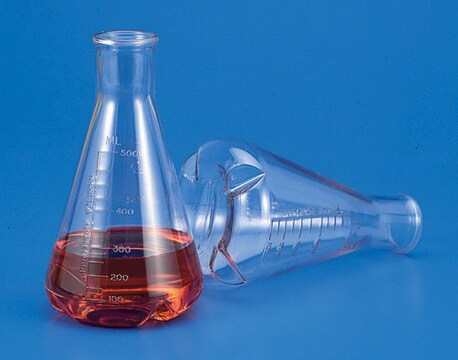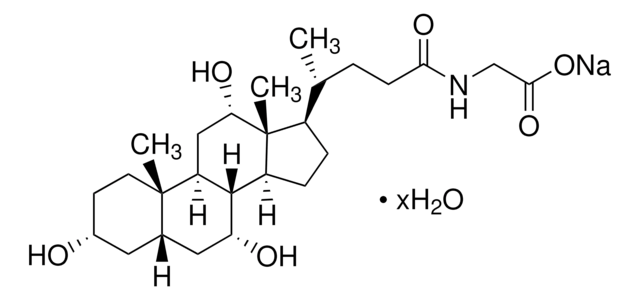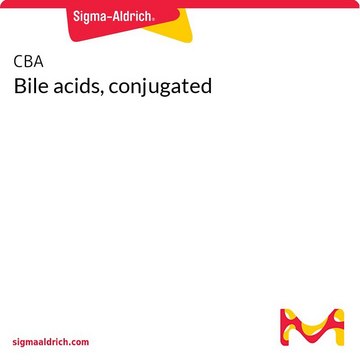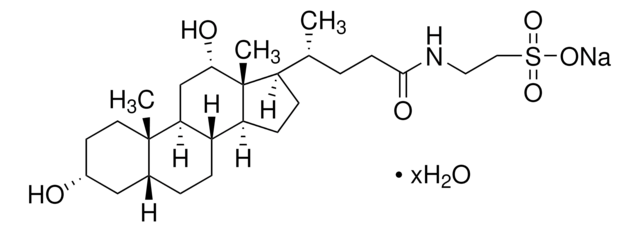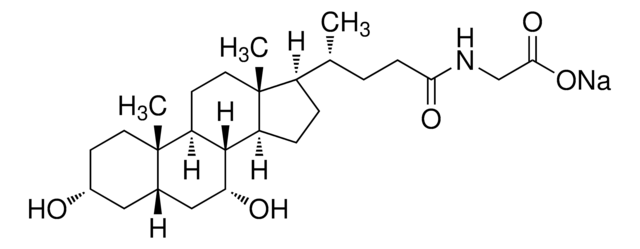Key Documents
G0759
Sodium glycochenodeoxycholate
Synonim(y):
3α,7α-Dihydroxy-5β-cholanoic acid N-(carboxymethyl)amide sodium salt, Glycochenodeoxycholic acid sodium salt, N-(3α,7α-Dihydroxy-24-oxocholan-24-yl)glycine sodium salt
About This Item
Polecane produkty
opis
anionic
Poziom jakości
Postać
powder
masa cząsteczkowa
471.61 g/mol
metody
HPLC: suitable
protein quantification: suitable
grupa funkcyjna
sulfonic acid
Warunki transportu
ambient
temp. przechowywania
room temp
ciąg SMILES
[Na+].C[C@H](CCC(=O)NCC([O-])=O)[C@H]1CC[C@H]2[C@@H]3[C@H](O)C[C@@H]4C[C@H](O)CC[C@]4(C)[C@H]3CC[C@]12C
InChI
1S/C26H43NO5.Na/c1-15(4-7-22(30)27-14-23(31)32)18-5-6-19-24-20(9-11-26(18,19)3)25(2)10-8-17(28)12-16(25)13-21(24)29;/h15-21,24,28-29H,4-14H2,1-3H3,(H,27,30)(H,31,32);/q;+1/p-1/t15-,16+,17-,18-,19+,20+,21-,24+,25+,26-;/m1./s1
Klucz InChI
AAYACJGHNRIFCT-YRJJIGPTSA-M
Szukasz podobnych produktów? Odwiedź Przewodnik dotyczący porównywania produktów
Opis ogólny
Zastosowanie
Działania biochem./fizjol.
zastąpiony przez
Kod klasy składowania
11 - Combustible Solids
Klasa zagrożenia wodnego (WGK)
WGK 3
Temperatura zapłonu (°F)
Not applicable
Temperatura zapłonu (°C)
Not applicable
Środki ochrony indywidualnej
Eyeshields, Gloves, type N95 (US)
Certyfikaty analizy (CoA)
Poszukaj Certyfikaty analizy (CoA), wpisując numer partii/serii produktów. Numery serii i partii można znaleźć na etykiecie produktu po słowach „seria” lub „partia”.
Masz już ten produkt?
Dokumenty związane z niedawno zakupionymi produktami zostały zamieszczone w Bibliotece dokumentów.
Klienci oglądali również te produkty
Produkty
Today, diverse studies report the benefits of probiotics, such as inhibitory effects on pathogens, aid in the management or prevention of chronic intestinal inflammatory diseases or atopic syndromes, and support to the immune system. Potential beneficial applications abound, researchers continue to evaluate the effictiveness and clarify the mechanisms of action of probiotics.
Protokoły
This method is particularly useful in research into the role of individual bile acids as signaling molecules; suitable for clinical laboratories to investigate potential mechanisms linked to gut hormone profiles and glycemic control.
Nasz zespół naukowców ma doświadczenie we wszystkich obszarach badań, w tym w naukach przyrodniczych, materiałoznawstwie, syntezie chemicznej, chromatografii, analityce i wielu innych dziedzinach.
Skontaktuj się z zespołem ds. pomocy technicznej

